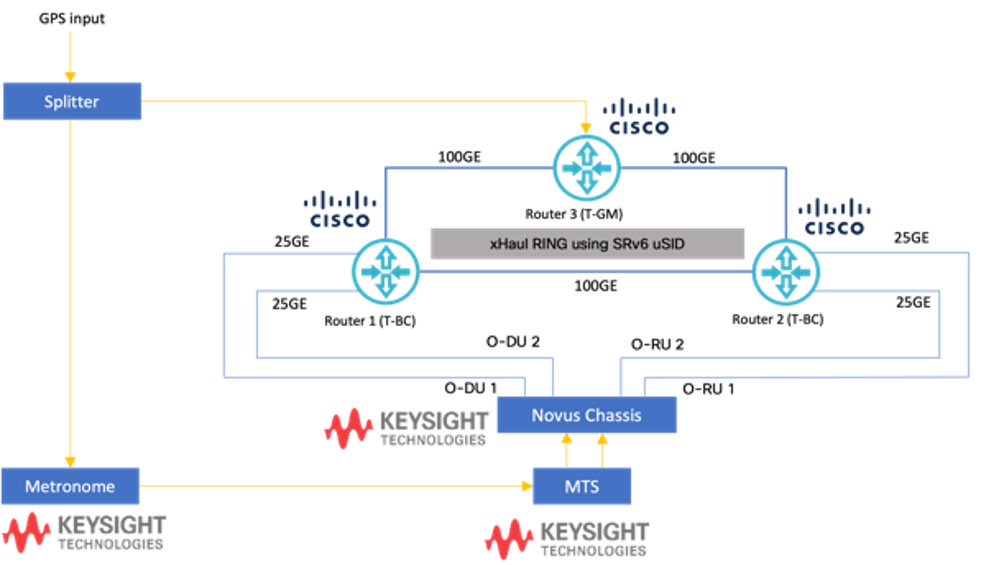5G services can’t succeed without flexible, efficient, and programmable transport. To support and capitalize on 5G services, 5G RAN transport architectures have evolved to support virtualization and slicing, strict latency, jitter, stringent synchronization, and multi-cloud interconnect architectures. Recent Cisco innovations have focused on segment routing and IPv6 to improve network reliability with traffic engineering and to simplify network complexity with programmable transport, providing 5G transport operators with more control and the ability to build performance-based service level agreements (SLAs).
SRv6 microSID for converged public and private 5G
A virtualized radio access network (RAN) architecture allows operators to rapidly and flexibly allocate resources across public and private 5G deployments. To accelerate time to market and bridge the skills gap, communication service providers (CSPs) are choosing to deploy their services in partnership with hyperscale cloud providers (HCPs). Additionally, as data centers move from centralized to distributed to increase coverage and reduce potential performance issues with cloud-based services, an agile and scalable transport network is critical as part of a hybrid or multi-cloud strategy.

Flexible service placement requires traffic engineering and end-to-end service quality assurance from the transport network. As well, transport slicing is critical to maintain guaranteed service quality and offer RAN service differentiation.

Slice awareness between the radio and the 5G core network is addressed by 3GPP specifications. To select the most optimal user plane function (UPF) demands, the underlying transport network must also be slice aware. Specific slice characteristics are dependent on the underlay 5G transport and how it allocates resources. The network can inspect slice information like the VLAN or ethernet header, classify the radio traffic to different slices, and allocate transport resources to meet varying levels of service from latency sensitive to best effort.

SRv6 excels when the network has many interconnected end points and complex traffic engineering requirements. It brings programmability to the 5G transport architecture. The packet processing program is expressed as a list of instructions which are represented as 128-bit segments called segment identifier (SID). In complex traffic engineering, there are scenarios that may require carrying several segments in the IPv6 packet headers. Reducing this overhead is useful to minimize the packet maximum transfer unit (MTU) and enable SRv6 on legacy hardware devices with limited processing capabilities.
The microSID (uSID) introduces extensions to the SRv6 programming model with each 16-byte SID able to carry micro-instructions called uSID. uSID are represented with two bytes, and up to six uSIDs can be carried in a SID.
SRv6 uSID benefits
With SRv6 uSID, the network can be programmed to handle complex scenarios with simplicity. This additional programmability comes with several advantages:
- No change to SRv6 control plane, data plane, or segment routing header (SRH)
- Any SID in the SID list can carry a uSID
- An SID can carry up to six program instructions
- No routing extension required to support
The result is an ultra-scalable network able to support multi-domain deployments with minimal MTU overhead.
SRv6 microSID and O-RAN ALLIANCE Plugfest
Cisco partnered with Keysight Technologies to successfully validate O-RAN ALLIANCE-specified 5G RAN traffic on an SRv6 microSID-based programmable 5G xHaul transport network. Traffic characteristics like latency, jitter, synchronization, and network convergence were measured for each service slice over a multihop ring topology architecture.

In the validation test, latency sensitive fronthaul control plane traffic was carried with an SRv6-uSID-based L2 transport slice over EVPN. Non-latency sensitive management traffic was carried with an SRv6 uSID-based L3 transport slice over L3VPN. Synchronization was provided by an aggregation router to all nodes including radio units and distributed units. The Keysight Novus tester was used to simulate multiple radio units and distributed units, while the Keysight Metronome Timing System (MTS) was used to measure synchronization accuracy and relative timing.
SRv6 microSID instructions programmed the network to ensure service assurance for each slice and traffic type with the following results:
- Latency sensitive slice: 11us and average jitter of ~600ns
- Non-latency sensitive slice: 28us
- Relative timing accuracy between radio nodes: <30ns relative |TE|
- Service convergence during transport link failure: <22ms
These results confirm that the 5G xHaul architecture with SRv6 microSID meets all characteristics defined by eCPRI, O-RAN, ITU-T, and 3GPP standards for fronthaul, midhaul, and backhaul traffic over converged multihop transport architecture.
Conclusion
SRv6 microSID is an open standards-based solution that many service providers have already deployed in their network and are realizing the benefits of such innovation. The Cisco Converged SDN Transport architecture and the scalable SRv6 connects mobile users, devices, sensors, application workloads, and cloud services to enable CSPs to address complex network interconnects and adopt a hybrid cloud architecture to offer differentiated services.
Additional Resources
O-RAN ALLIANCE Plugfest Validation of WG9 xHaul with Keysight
MPLS WC 2022 – Rakuten: SRv6 uSID in Deployment to Deliver End-to-end 5G Network Slicing

> Non-latency sensitive slice: 28ns
Should be 28ms?
28ns=0.028 usec, shorter than latency sensitive slice (11us), doesn’t make sense.
Thank you for sharing your observation and interest in the solution.
The latency for non-eCPRI and non-latency sensitive traffic, over multi-hop Xhaul network, was recorded as 28us (micro second).